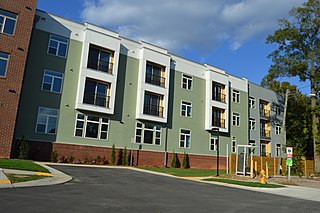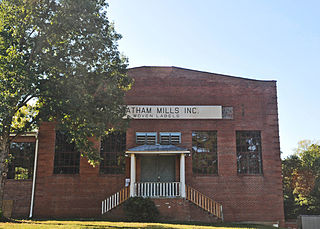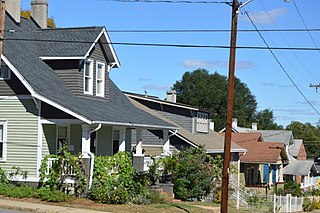
Green Level is an unincorporated community near the town of Cary in southwestern Wake County, North Carolina, United States. It was founded around 1800, and is one of the oldest surviving crossroads communities in the Raleigh area.

The Maiden Lane Historic District is a national historic district located at Raleigh, North Carolina. The district encompasses 12 contributing residential buildings and was developed between about 1893 and 1923. The district includes notable examples of Queen Anne and Colonial Revival style architecture. Notable houses include the Isabella Morrison Hill House, Irby-Brewer House, Allie H. Kirks House, Love Virginia Davis House, and Frank Brown House (1923).

Halifax Historic District is a national historic district located at Halifax, Halifax County, North Carolina, US that was listed on the National Register of Historic Places in 1970 with an increase in 2011. It includes several buildings that are individually listed on the National Register. Halifax was the site of the signing of the Halifax Resolves on April 12, 1776, a set of resolutions of the North Carolina Provincial Congress which led to the United States Declaration of Independence gaining the support of North Carolina's delegates to the Second Continental Congress in that year.

Catawba Historic District is a national historic district located at Catawba, Catawba County, North Carolina. The district encompasses 48 contributing buildings and 1 contributing structure in the rural village of Catawba. It contains 19th century farmhouses and tracts of farmland with scattered outbuildings as well as village residences and a small commercial district. The district includes notable examples of Gothic Revival, Victorian, and Bungalow / American Craftsman architecture. Notable buildings include the Bagby-Danner Farmhouse, Jacob D. Little House, Town Hall, Dr, Fred Y. Long Farm, Catawba ·Baptist Church, (former) Catawba High School (1921), Quintus M. Little House, Trollinger-Sherrill House, Brawley-Lowrance House, Pitts-Little House (1924), Manson L. Wilkinson· House, Sherrill Tobacco Company Building, Catawba Drug Company, Pitts-Carpenter Building, Long and Company Store, and the Methodist Church.

Claremont High School Historic District is a national historic district located at Hickory, Catawba County, North Carolina. The district encompasses 172 contributing buildings and 3 contributing structures in a predominantly residential section of Hickory. Most of the dwellings date from the late 19th through mid-20th century and include notable examples of Queen Anne, Colonial Revival, Tudor Revival, and Bungalow / American Craftsman style architecture. The Claremont High School was completed in 1925, and is a three-story, "H"-shaped, Neoclassical style school. The school was rehabilitated in 1986 as an arts and science center. Other notable buildings include Maple Grove, Shuler-Harper House (1887), Harvey E. McComb House (1889), (former) Corinth Reformed Church Parsonage (1895), Shuford L. Whitener House, Judge W. B. Councill House (1902), George W. Hall House, Carolina Park, Josephine Lyerly House, John L. Riddle House (1918), Marshall R. Wagner House (1938), David M. McComb Jr., House (1939), Arthur H. Burgess House (1940), and R. L. Noblin House (1950).

Pittsboro Historic District is a national historic district located at Pittsboro, Chatham County, North Carolina. The district encompasses 131 contributing buildings, 3 contributing sites, and 1 contributing object in the county seat of Pittsboro. Located in the district and separately listed are the Chatham County Courthouse, the Hall-London House, the Moore-Manning House, the Reid House, the Lewis Freeman House, the McClenahan House, and the Patrick St. Lawrence House. Other notable buildings include the Blair Hotel, Pilkington Drug Store / S & T' s Soda Shoppe, Justice Motor Company building (1949), St. Bartholomew's Episcopal Church (1832), Pittsboro United Methodist Church, and Queen Anne style Henry H. Fike House.

West Salem Historic District is a national historic district located at Winston-Salem, Forsyth County, North Carolina. The district encompasses 591 contributing buildings, 1 contributing site, and 3 contributing structures in a largely residential section of Winston-Salem. The buildings date from about 1843 to 1957, and include notable examples of Colonial Revival, Queen Anne, and American Craftsman style architecture, as well as bungalows. Notable resources include the M. D. Gantt Building (1931), Coca-Cola Bottling plant (1930), Christ Moravian Church (1895), and Green Street Methodist Church (1921).

Foust–Carpenter and Dean Dick Farms are two historic farms and national historic district located near Whitsett, Guilford County, North Carolina. The district encompasses 27 contributing buildings and 1 contributing site and includes houses and agricultural outbuildings dating from the late-19th to mid-20th century. They include the John C. and Barbara Foust House, Tenant House / John B. and Lucille Carpenter House, two barns, corn crib, packhouse, tobacco barn, Tenant House, Carpenter Lake House (1940s), and Milking Barn.

Weldon Historic District is a national historic district located at Weldon, Halifax County, North Carolina. It encompasses 256 contributing buildings, 2 contributing structures, and 9 contributing structures in the central business district and surrounding residential sections of the town of Weldon. The district includes notable examples of Queen Anne, Colonial Revival, and Bungalow / American Craftsman style architecture. The district overlaps the Roanoke Canal Historic District. Notable buildings include the Larkin-Hart House, Ashley L. Stainback House c. (1879), Smith-Dickens House (1901-1902), DeLeon F. Green House (1934) designed by William Lawrence Bottomley, Emry-Zollicoffer Building (1877), Bank of Weldon Building, George C. Green Building/Bank of Halifax Building (1915), Weldon Grocery Company Building (1913), (former) Weldon Town Hall (1893), United States Post Office (1938), Weldon Freight Depot, Coca-Cola Bottling Company (1925), and Atlantic Coast Line Railroad Embankment and Viaduct.

Fairfield Historic District is a national historic district located at Fairfield, Hyde County, North Carolina. The district encompasses 54 contributing buildings, 1 contributing site, and 1 contributing structure in the village of Fairfield. The district includes notable examples of Italianate and Carpenter Gothic style architecture dating to the last half of the 19th century. Notable buildings include the Blackwell-Carter-Midyette House (1850s), Dr. Patrick Simmons House (1871), Carter~Holton-Sears House, Fairfield Methodist Episcopal Church (1877), E. S. O'Neal And Sons Store, Calhoun Brown Store, Fairfield Cemetery Pavilion, and Carter-Swindell House (1870s).

Academy Hill Historic District is a national historic district located at Statesville, Iredell County, North Carolina. It encompasses 40 contributing buildings in a mixed-use neighborhood of Statesville. The district includes notable examples of Late Victorian architecture including primarily brick educational and industrial buildings and one and two-story frame dwellings. They were mainly built between 1885 and 1930. Notable buildings include the former Statesville Male Academy (1874), Statesville Graded School (1892), J. C. Steele & Sons Brick Machinery Plant, Ash Tobacco Factory, O. W. Slane Glass Company, J. C. Steele House (1880s), C. M. Steele House (1901), H. Oscar Steele House, and William E. Webb House.

Hamilton Historic District is a national historic district located at Hamilton, Martin County, North Carolina. The district encompasses 60 contributing buildings, 2 contributing sites, and 1 contributing structure in the town of Hamilton. They include notable examples of Greek Revival, Queen Anne, and Carpenter Gothic architecture in buildings dated from the early-19th century through the 1920s. Located in the district is the separately listed Darden Hotel. Other notable buildings include the Edmondson-Purvis House, Upton-Pippen house, Conoho Masonic Lodge, Weatherbee-Anthony House, David L. Martin House, Baker-Ballard House, St. Martin's Episcopal Church, Gladstone Building, Hamilton Methodist Church (1903), and Hamilton Baptist Church (1929).

Old Fort Commercial Historic District is a national historic district located at Old Fort, McDowell County, North Carolina. The district encompasses 11 contributing buildings, 1 contributing structure, and 1 contributing object in the central business district of Old Fort. It includes notable examples of Italianate, Romanesque Revival and Art Moderne architecture built between 1894 and 1960. Notable buildings include the Bank of Old Fort, Rockett Motors, Roxy Theatre, and Railroad Depot (1894).

Hertford Historic District is a national historic district located at Hertford, Perquimans County, North Carolina. The district encompasses 219 contributing buildings, 2 contributing sites, 1 contributing structure, and 1 contributing object in the central business district and surrounding residential sections of Hertford. The district developed between about 1759 and 1948, and includes notable examples of Federal, Greek Revival, and Gothic Revival style architecture. Located in the district are the separately listed Perquimans County Courthouse and Church of the Holy Trinity. Other notable buildings include the Creecy-Skinner-Whedbee House, Edward Wood House, Matthews-Jacocks House, Temperance Hall (1851), Matthew H. White House, Dr. Thomas S. McMullan House (1905), Thomas Nixon House, William M. Divers House (1924), W.R. Shannonhouse Building (1895), Darden Department Store, Farmers National Bank of Hertford (1916), State Theatre (1937), Old Hertford Post Office (1915), Hertford Baptist Church (1854), and Hertford United Methodist Church (1901).

Belvidere Historic District is a national historic district located at Belvidere, near Hertford, Perquimans County, North Carolina. The district encompasses 68 contributing buildings, 3 contributing sites, and 6 contributing structures in the rural agricultural area around the village of Belvidere. The district developed between about 1800 and 1949, and includes notable examples of Federal and Greek Revival style architecture. Notable buildings include the Joseph Smith House, Rufus White House, Edwin S. White Farm, Fernando C. White Mill Complex, John J. Chappell, Jr. Farm, and Murray and Fernando C. White Farm.

Renston Rural Historic District is a national historic district located near Winterville, Pitt County, North Carolina. The district encompasses 105 contributing buildings, 6 contributing sites, 7 contributing structures, and 1 contributing object on eight major farms in rural Pitt County near Winterville. It includes buildings largely dated from about 1890 to 1953 and notable examples of Greek Revival and Classical Revival style architecture. They include the Fletcher Farm, the Charles and Maggie McLawhorn farms, the Langston-Edwards properties, the Dail Farm, the Dennis McLawhorn farms, the McLawhorn-Abbott property, and the Richard Herman McLawhorn farms. Notable individual buildings include the Joseph Smith House, former Renston School and the first Bethany Free Will Baptist Church, Spier Worthington House, Langston-Edwards House, the Dail House, and the Charles McLawhorn House.

Saluda Main Street Historic District is a national historic district located at Saluda, Polk County, North Carolina. The district encompasses 16 contributing buildings, 1 contributing site, and 1 contributing structure in the central business district of Saluda. It includes buildings dated from about 1878 to 1946 and notable examples of Late Gothic Revival and Stick style / Eastlake Movement architecture. Notable buildings include the Saluda Presbyterian Church (1895-1896), former Saluda Depot, the Saluda City Hall (1896-1907), the M. A. Pace Store (1905-1910), Thompson's Store (1905-1910), Pebbledash Building (1911-1916), Top Service Station (1930s), and the former United States Post Office.

Jones–Johnson–Ballentine Historic District is a national historic district located near Fuquay-Varina, Wake County, North Carolina. The district encompasses 18 contributing buildings, 3 contributing sites, and 8 contributing structures on the Johnson Farm and the Ballentine Farm near Fuquay-Varina. The district includes notable examples of Classical Revival and Victorian style architecture. Notable resources include the William Wesley Johnson House, The Log Cabin, James E. Ballentine House (1890), The Creamery, Dairy Barn (1915), a family cemetery and the surrounding farm landscape.

Downtown Wake Forest Historic District is a national historic district located at Wake Forest, Wake County, North Carolina. The district encompasses 25 contributing buildings, 1 contributing structure, and 1 contributing object built between about 1890 and 1949 and located in the central business district of the town of Wake Forest. It includes notable examples of Colonial Revival and Art Deco style architecture. Notable buildings include the Lovelace Building (1940s), Dick Frye Restaurant (1940s), Powers-Barbee Building, Wilkinson Building (1899), B&S Department Store, Arrington Building (1915), Bank of Wake (1895), Wake Forest Post Office (1914), Collegiate Theater (1915), and Wake Forest Post Office (1940).

Valle Crucis Historic District is a national historic district located at Valle Crucis, Watauga County, North Carolina. The district encompasses 50 contributing buildings, 1 contributing site, and 7 contributing structures in the central business district and surrounding residential sections of Valle Crucis. It developed between about 1812 and 1954, and includes notable examples of Gothic Revival, Bungalow / American Craftsman, and Colonial Revival style architecture. Located in the district are the separately listed Mast General Store, Mast Farm, and Valle Crucis Episcopal Mission. Other notable contributing buildings are the Baird Farm, Lucy Mast Olsen House (1936-1940), Taylor tobacco barn, Farthing Store (1909), Valle Crucis Bank (1914), Hard Taylor House, and C. D. "Squire" Taylor House (1911).















